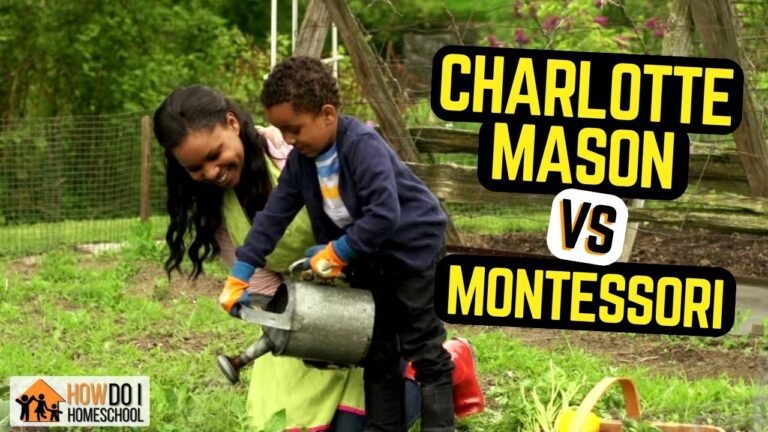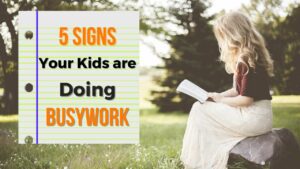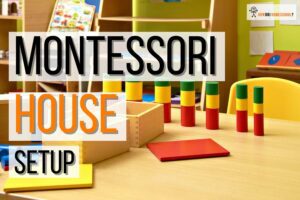Education is a fascinating field, and two prominent hands-on homeschooling approaches exist and are often compared: Charlotte Mason vs Montessori. These philosophies or theories have shaped children’s learning, especially in early childhood and homeschool environments. Both approaches emphasize putting the child at the center of the learning experience, but they have unique principles and practices. This article will examine Charlotte Mason and Montessori education, exploring what sets them apart and how they approach teaching and learning.
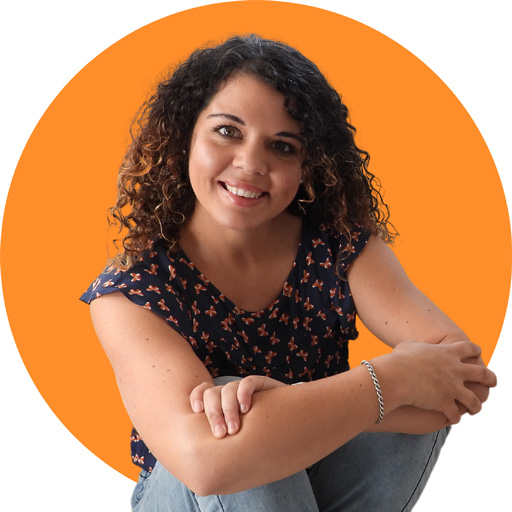
I hope you enjoy reading this blog post. If you want to do my course on how to homeschool, click here.
Let’s take a closer look at the similarities and differences of the Charlotte Mason vs Montessori methods.
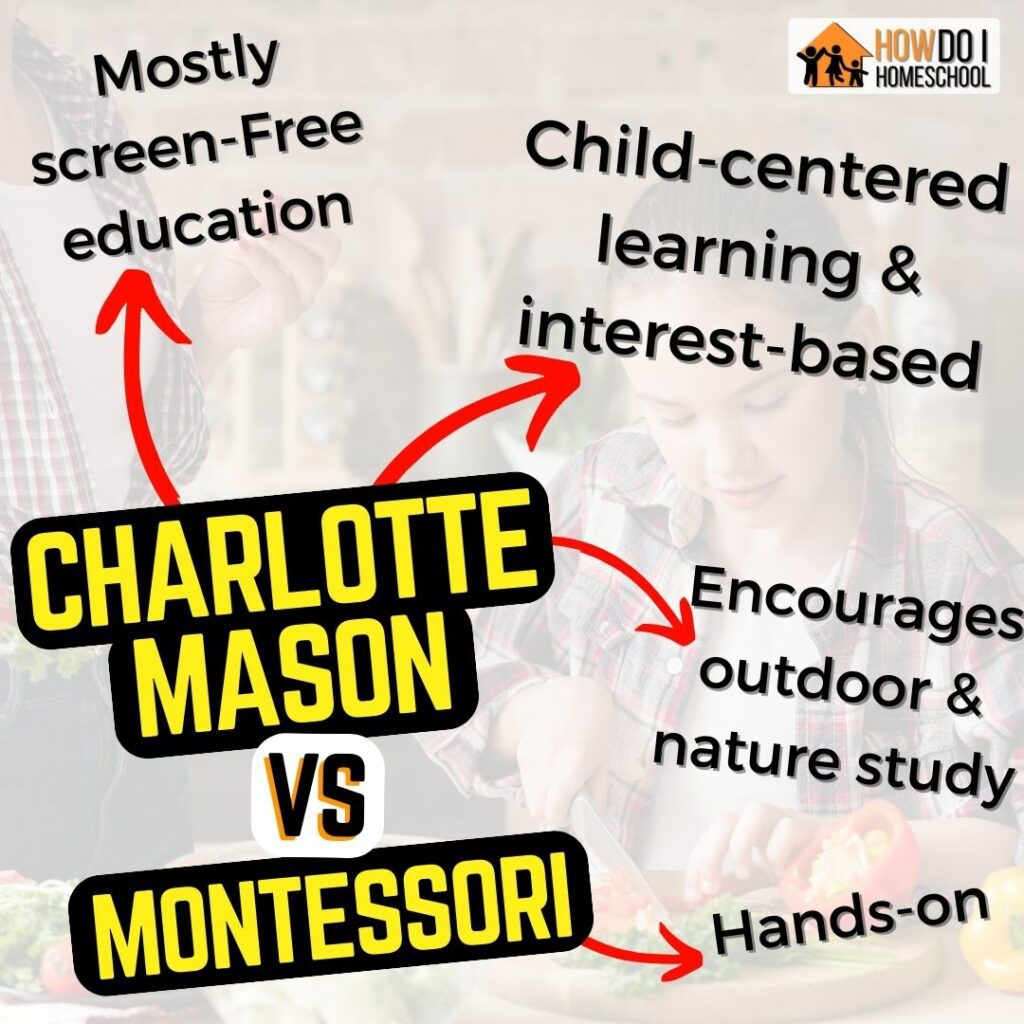
Affiliate links are used in this post.
Charlotte Mason vs Montessori (in a Nutshell)
Charlotte Mason and Montessori are two distinct educational approaches used in schools and homeschools particularly in early childhood.
Charlotte Mason, developed in the late 19th and early 20th centuries, focuses on a well-rounded education, emphasizing good habits, a love for learning, and moral character development through living books and outdoor activities.
On the other hand, Montessori, created by Maria Montessori in the early 20th century, is known for its hands-on, child-centered approach, promoting self-directed exploration with carefully designed materials in a prepared environment.
While both prioritize the child’s individual growth, Charlotte Mason leans towards a liberal arts education, while Montessori emphasizes sensory experiences and practical life skills.
Religious Beliefs in Montessori vs Charlotte Mason
Charlotte Mason education also links education to understanding God and, therefore, understanding ourselves. She incorporated Christian beliefs into her curriculum.
Montessori is relatively secular in comparison, and Montessori schools tend to be quite non-religious, although Maria Montessori was a Catholic.
But let’s take a look at each philosophy separately and then make a comparison of the two homeschool methods at the end.
The Charlotte Mason Method
The Charlotte Mason method differs from anything you’ll usually find in a school.
It’s popular in homeschool circles and well-loved by nature enthusiasts.
Philosophy and Principles
Charlotte Mason, originally a classical educator, was influential in the late 19th and early 20th centuries. She believed in a well-rounded education for all children, no matter if they were rich or poor.
Mason thought of children as whole individuals, focusing on building good habits, nurturing a love for learning, and incorporating the arts into education.
She also liked incorporating a lot of nature into a child’s study as she firmly believed that nature was God’s teacher.
Central to Mason’s approach are the following:
- ‘living books,’ which are educational storybooks written by people who were experts and loved their subject,
- narrations, which is a child repeating back info they’ve heard so they cement knowledge and learn good public speaking skills,
- and the development of a child’s moral character.
These all play a significant part in how the curriculum looks.
Curriculum and Methods
Mason’s curriculum covers various subjects, including literature, nature study, art, music, and languages. Some credit her as the instigator of Scouts and Girl Guides.
Short lessons so children won’t get frustrated and love learning, nature walks to increase physical strength and a connection with the outdoors for better health and mental health, and the use of living books (which have some overlap with great books) are critical aspects of Mason’s teaching methods.
Narration, where students express what they’ve learned, is vital for comprehension and retention. Narration could happen in an oral format as a child repeats back what he’s learned, a written format (like a letter or essay), a drama format (through plays), a science format (through STEM display), and more formats. (Here are some narration ideas if you’re interested. Or you could use narration cards.)
Environment
Valuing a tranquil and organized learning environment for improved focus, Mason emphasized the importance of nature in her philosophy, encouraging outdoor activities and nature study as integral components of the learning experience.
Additionally, Mason introduced Morning Time. Morning time consists of a family-oriented session post-breakfast.
The parent in charge would collect her ‘morning basket,’ a stack of fun curriculum ideas. Parents could choose what to do in this spot, but many chose things like
- exploring poetry,
- reading the Bible or doing a Bible curriculum,
- prayer, and perhaps delving into a bit of foreign language study.
Morning Time helps foster good family connections and a joyful and collective learning atmosphere.
Mason mainly wrote about her methods in her Home Education series, the first of which is narrated on the audiobook below.
The Montessori Method
But, the Montessori method is quite different. Let’s take a look.
Philosophy and Principles
Italian physician and educator Maria Montessori founded the Montessori method in the early 20th century.
This approach is centered on child-centered education, emphasizing hands-on learning and the belief in a child’s innate ability to learn.
Despite Maria Montessori’s Catholic background, Montessori schools tend to adopt a secular and non-religious stance.
Curriculum and Methods
Montessori classrooms are characterized by carefully designed materials that facilitate self-directed learning.
The curriculum is divided into five main areas, which are briefly described below.
-
- Practical Life: Develops independence and fine motor skills through everyday tasks like pouring and buttoning.
- Sensorial: Hones sensory perceptions through activities involving touch, sight, sound, taste, and smell.
- Mathematics: Makes abstract math concepts tangible with hands-on activities covering counting, place value, and operations.
- Language: Progresses from spoken language to reading and writing, building a foundation in literacy.
- Cultural Studies: Explores geography, history, biology, and science, fostering curiosity about the world.
Children are encouraged to explore these areas at their own pace, promoting independence and individualized progress. Uninterrupted work periods and mixed-age classrooms contribute to the unique Montessori learning environment.
Environment
Montessori classrooms or homeschool environments are organized to promote independence, with child-sized furniture and materials accessible to students (see a Montessori Homeschool setup of a room, bedroom, and garden here).
Nature and real-world experiences are integrated into the curriculum, enhancing the connection between the child and the broader world.
The emphasis on a prepared environment extends to fostering a sense of order and responsibility, allowing children to develop practical life skills.
Unlike Charlotte Mason, Montessori doesn’t incorporate specific family-oriented sessions like Morning Time but focuses on creating a self-sufficient and collaborative atmosphere within the classroom or homeschool setting.
Comparing Charlotte Mason vs Maria Montessori
So, let’s compare the two methods side by side. We’ll take a look at the Teacher’s Role, the approach to learning, and what testing and evaluation looks like.
Teacher Role
Charlotte Mason
In the Charlotte Mason curriculums, teachers play a guiding role, emphasizing the importance of cultivating good habits and instilling a love for learning.
Charlotte Mason educators are perceived as knowledgeable authorities capable of imparting their expertise.
Montessori
On the other hand, Montessori teachers take on the role of observers, guiding and supporting children in their independent exploration.
While they share knowledge, the focus is more on the child’s interests, and the emphasis on fostering moral and godly habits is less pronounced.
Approach to Learning
Charlotte Mason values a comprehensive liberal arts education, giving prominence to literature, nature, and the arts. The emphasis is on a well-rounded exposure to various subjects.
In contrast, Montessori education strongly emphasizes sensory experiences and hands-on learning. This is achieved through carefully designed materials that allow children to explore and learn at their own pace.
Assessment and Evaluation
In the Charlotte Mason approach, assessment leans towards informal methods such as narration and discussion, steering away from traditional testing.
Mason believes in capturing a child’s understanding through conversation and expression rather than formal assessments.
Montessori, in contrast, avoids traditional grading and testing altogether.
The focus is on continuous observation of a child’s development, allowing educators to adapt and tailor the learning environment based on the child’s individual progress and needs.
Charlotte Mason Curriculum
If you’re interested in Charlotte Mason curriculum programs, check these options:
- A Gentle Feast – video lessons, support calls, schedules, and online curriculum
- Ambleside Online – a free curriculum with schedules and booklists
- Heart of Dakota – a mailable program
- Great Books Homeschool – a secular Charlotte Mason homeschool curriculum
These all differ in content and format but generally stay true to the CM methodology.
The Bottom Line on Charlotte Mason vs Montessori…
Both Charlotte Mason and Montessori education are committed to child-centered learning but differ in their specific methodologies. Choosing between them depends on individual preferences, educational goals, and the child’s needs. By understanding the fundamental principles of each philosophy, parents and educators can make informed decisions that align with their values for the educational journey of the children in their care.
